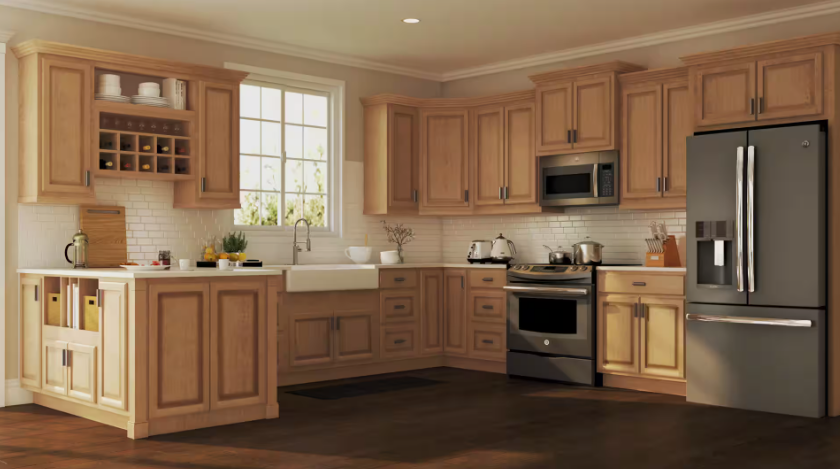The kitchen is often considered the heart of a home, where families gather, meals are prepared, and memories are made. As we become increasingly aware of the environmental impacts of our choices, sustainable design has become more popular. One area where this shift is particularly noticeable is in eco-friendly kitchen renovations. Choosing environmentally conscious kitchen cabinets not only enhances the beauty and function of your home, but also contributes to a more sustainable planet.
In this article, we’ll dive into eco-friendly kitchen cabinets, the materials that make them sustainable, tips to make your choice easier, and the trends to watch. We’ll also address a key figure in kitchen cabinetry, Dave the Cabinet Guy, and how his expertise can help in selecting the right eco-friendly options.
Why Eco-Friendly Kitchen Cabinets?
As sustainability moves into the spotlight, it’s no surprise that people are looking for ways to reduce their environmental footprint. Kitchen cabinetry is a major part of any kitchen remodel, and opting for eco-friendly cabinets offers several important benefits, including:
- Reduced Carbon Footprint: Eco-friendly materials require less energy to produce and emit fewer pollutants.
- Healthier Indoor Air Quality: Many traditional cabinets are made from particleboard or MDF that emit volatile organic compounds (VOCs) that can harm indoor air quality. Eco-friendly alternatives use lower-emission materials that keep your home’s air clean.
- Longevity: Sustainable materials tend to be more durable, which means you’ll enjoy long-lasting, high-quality cabinetry.
- Aesthetic Appeal: Eco-friendly cabinets often have a natural, clean look that blends seamlessly with a variety of home styles.
Materials for Eco-Friendly Kitchen Cabinets
When searching for sustainable materials for your kitchen, it’s essential to look beyond mere aesthetics. Consider the following eco-friendly options that provide style and substance.
1. Reclaimed Wood Cabinets
Reclaimed wood is one of the best options for eco-friendly cabinets, and for good reason. This material involves repurposing old wood from buildings, barns, and other structures rather than harvesting fresh timber. By doing so, it helps reduce deforestation and uses existing resources instead of relying on new materials.
Benefits of Reclaimed Wood:
- Sustainability: Reduces demand for new timber, which helps prevent deforestation.
- Unique Aesthetic: Reclaimed wood has a rich, weathered look that adds character and charm to kitchens.
- Durability: Old wood is often denser and stronger than newly cut timber, ensuring your cabinets will last.
2. Bamboo
Bamboo is rapidly becoming one of the most popular eco-friendly materials for cabinetry due to its fast growth rate and renewable nature. Bamboo can be cultivated and harvested quickly, making it an incredibly sustainable choice. It’s also sturdy, versatile, and often used in modern kitchen designs.
Benefits of Bamboo:
- Renewable: Bamboo grows significantly faster than most hardwood trees.
- Durable: Bamboo is strong, which makes it great for kitchen cabinets that see frequent use.
- Aesthetic Appeal: Its natural pattern and color variations can give your kitchen a fresh, organic feel.
3. Low-VOC (Volatile Organic Compound) Finishes and Paints
Many conventional paints and finishes for cabinets contain VOCs that can have harmful effects on air quality and health. Low-VOC or no-VOC finishes, however, are made using water-based, non-toxic ingredients. They offer the same durability and aesthetic appeal without the dangerous chemicals.
Benefits of Low-VOC Finishes:
- Healthier Home: Reduces exposure to toxins in the air.
- Variety: Available in a wide range of colors and finishes, providing more style options.
4. Recycled Materials
Recycled materials such as plastic, glass, and even metal are excellent eco-friendly options for cabinetry. These materials are repurposed from existing products, helping reduce waste and supporting a circular economy. Plus, recycled materials are often high in quality and can result in unique, eye-catching cabinet designs.
Benefits of Recycled Materials:
- Waste Reduction: Keeps unwanted materials out of landfills.
- Distinctive Aesthetic: Recycled materials often have unique textures and colors that can’t be easily replicated with traditional wood.
5. Solid Wood Cabinets from Certified Sources
When wood is a preferred material for your kitchen cabinets, ensure that it’s sourced from certified sustainable forests. Look for certifications such as FSC (Forest Stewardship Council) that guarantee the wood comes from responsibly managed forests.
Benefits of Certified Wood:
- Sustainability: Ensures trees are replanted and forests are managed responsibly.
- Quality: Solid wood is durable and can last for many years, making it a sound investment.
Tips for Choosing Eco-Friendly Kitchen Cabinets
Selecting the right eco-friendly cabinets may seem daunting, but with the following tips, you can make an informed and confident decision:
1. Research Your Options
The market is full of materials and cabinet types that cater to different needs. Before making any decisions, take time to research available eco-friendly materials and understand their benefits. This research will help you decide which material is the best fit for your kitchen style, budget, and sustainability goals.
2. Consult an Expert Like Dave the Cabinet Guy
One of the best steps you can take is to work with a professional who specializes in eco-friendly cabinetry. Dave the Cabinet Guy, for example, has extensive experience working with sustainable materials and designing kitchens that prioritize both aesthetics and sustainability. An expert like Dave can guide you through the process, ensuring you choose quality cabinets that align with your environmental values.
3. Opt for Customization
Custom-made cabinets allow you to choose every element that goes into your cabinetry, from the wood to the finishes. By opting for a local manufacturer, you can help reduce the carbon footprint of transportation, while also ensuring that your materials meet your eco-friendly standards.
4. Check for Certifications
For materials like wood and paint, look for certifications such as FSC or Green Guard. These labels indicate that the products meet specific environmental and health standards, ensuring that you’re making an informed, green choice.
5. Consider the Full Lifecycle
Beyond just choosing eco-friendly materials, consider the full lifecycle of your cabinets. Are they durable and designed for long-term use? Are the manufacturing processes environmentally responsible? Selecting cabinets that can be reused, repurposed, or recycled at the end of their life will make your choice even more sustainable.
Trends in Eco-Friendly Kitchen Cabinets
As sustainability continues to shape the home design industry, several trends are emerging in the world of eco-friendly kitchen cabinets:
1. Natural Wood and Earthy Finishes
Natural wood finishes, such as walnut, oak, and maple, are gaining popularity due to their timeless appeal and sustainability. Pairing these finishes with neutral and earthy tones allows the cabinets to blend seamlessly with a range of kitchen styles.
2. Smart Storage Solutions
As more homeowners prioritize sustainability, there is a shift toward more efficient and functional cabinet designs. Smart storage solutions, such as pull-out shelves, soft-close drawers, and dividers, ensure that your kitchen functions efficiently while cutting down on unnecessary materials.
3. Minimalist Designs
Minimalist kitchen designs are embracing clean lines and simple styles that minimize waste and clutter. This trend often goes hand-in-hand with sustainable design principles, as fewer elements are needed to create a cohesive look.
4. Open Shelving and Floating Cabinets
Open shelving is a growing trend that both reduces the need for additional cabinetry and creates an airy, light look in the kitchen. This design approach encourages creativity in displaying kitchen essentials and accents, while also reducing materials.
Frequently Asked Questions
1. Are eco-friendly cabinets more expensive than traditional ones?
Eco-friendly cabinets can sometimes have a higher initial cost due to the quality of sustainable materials and manufacturing processes. However, over time, they can prove more cost-effective due to their durability and lower maintenance costs. Additionally, some eco-friendly choices can even qualify for tax incentives or rebates in certain areas.
2. How long do eco-friendly kitchen cabinets last?
The lifespan of eco-friendly kitchen cabinets largely depends on the materials chosen and the quality of the craftsmanship. Solid wood, bamboo, and reclaimed materials are all known for their durability. Eco-friendly cabinets are often designed to last much longer than traditional alternatives.
3. How do I maintain eco-friendly kitchen cabinets?
Maintaining eco-friendly cabinets is similar to caring for traditional cabinets. Regular cleaning with mild soap and water, avoiding harsh chemicals, and using protective finishes will keep your cabinets in top condition. Proper care ensures they continue to look good and last for many years to come.
Conclusion
Opting for eco-friendly kitchen cabinets is not only a way to reduce your environmental impact but also an investment in long-term quality and beauty for your kitchen. With sustainable options like reclaimed wood, bamboo, and low-VOC finishes, the possibilities are endless. Whether you decide to work with Dave the Cabinet Guy or another trusted expert, your decision to go green will ensure that your kitchen is both functional and eco-conscious for years to come.


